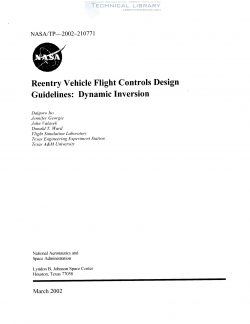NASA-TP-2002-210771
- Version
- 101 Downloads
- 4.13 MB File Size
- 1 File Count
- September 11, 2017 Create Date
- September 11, 2017 Last Updated
NASA, Technical Paper - Reentry Vehicle Flight Controls Design Guidelines; Dynamic Inversion

This document is a product of a research project initiated in February 1999 by the X—38 Flight
Controls Branch at the NASA Johnson Space Center (J SC). Funded by NASA Grant NAG9-1085,
the effort was associated with the Flight Mechanics Laboratory (FML) of the Texas Engineering
Experiment Station — the research arm of the Dwight Look College of Engineering at Texas A&M
University (TAMU). One of the tasks of the unsolicited proposal that led to this grant was to provide a
set of design guidelines that could be used in future by J SC . The subject of these guidelines was to be a
flight control design for vehicles operating across a broad flight regime and with highly nonlinear physical
descriptions of motion. The guidelines specifically were to address the need for reentry vehicles that
could operate, as the X-38 does, through reentry from space to controlled touchdown on the Earth’s
surface. The latter part of controlled descent was to be achieved by parachute or paraglider — or by an
automatic or a human- controlled landing similar to that of the space shuttle Orbiter.
Since these guidelines address the specific needs of human-carrying (but not necessarily piloted)
reentry vehicles, they deal with highly nonlinear equations of motion, and their generated control systems
must be robust across a very wide range of physics. Thus, this first- generation document deals almost
exclusively with some form of dynamic inversion (D1), a technique that has been widely studied and
applied within the past 25 to 30 years. Comprehensive and rigorous proofs now exist for transforming
a nonlinear system into an equivalent linear system. (Called either feedback linearization or D], it is
based on the early papers of Krener and Brockettl ‘2.) At about the same time, theoretical advances
essentially completed the background for ensuring the feedback control laws that make prescribed
outputs independent of important classes of inputs; namely, disturbances and decoupled control effectors.
These two vital aspects of control theory — noninteracting control laws and the transformation
of nonlinear systems into equivalent linear systems — are embodied in what is often called DI. Falb and
Wolovich3 considered noninteractions as a facet of linear systems theory. Singh, Rugh, Freund, and
Porter“‘“ extended these notions into nonlinear systems. lsidori and his colleaguesT‘ contributed
significantly to D1 theory by using mathematical notions fi'om differential geometry. Balas and his
colleagues applied these ideas to a variety of aerospace flight control system designs — including the F-
18 high angle-of-attack research vehicle (HARV)9 as well as to the X—38“I itself.
| File | Action |
|---|---|
| NASA-TP-2002-210771 Reentry Vehicle Flight Controls Design Guidelines; Dynamic Inversion.pdf | Download |
Comment On This Post